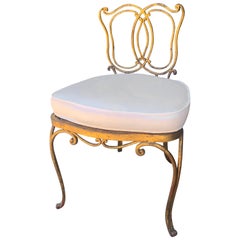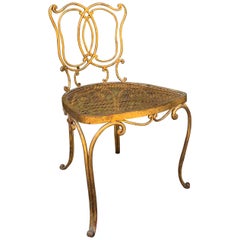Jean Charles Moreux Vanity Stool
Recent Sales
20th Century French Mid-Century Modern Slipper Chairs
Wrought Iron
20th Century French Mid-Century Modern Slipper Chairs
Wrought Iron
A Close Look at mid-century-modern Furniture
Organically shaped, clean-lined and elegantly simple are three terms that well describe vintage mid-century modern furniture. The style, which emerged primarily in the years following World War II, is characterized by pieces that were conceived and made in an energetic, optimistic spirit by creators who believed that good design was an essential part of good living.
ORIGINS OF MID-CENTURY MODERN FURNITURE DESIGN
- Emerged during the mid-20th century
- Informed by European modernism, Bauhaus, International style, Scandinavian modernism and Frank Lloyd Wright’s architecture
- A heyday of innovation in postwar America
- Experimentation with new ideas, new materials and new forms flourished in Scandinavia, Italy, the former Czechoslovakia and elsewhere in Europe
CHARACTERISTICS OF MID-CENTURY MODERN FURNITURE DESIGN
- Simplicity, organic forms, clean lines
- A blend of neutral and bold Pop art colors
- Use of natural and man-made materials — alluring woods such as teak, rosewood and oak; steel, fiberglass and molded plywood
- Light-filled spaces with colorful upholstery
- Glass walls and an emphasis on the outdoors
- Promotion of functionality
MID-CENTURY MODERN FURNITURE DESIGNERS TO KNOW
- Charles and Ray Eames
- Eero Saarinen
- Milo Baughman
- Florence Knoll
- Harry Bertoia
- Isamu Noguchi
- George Nelson
- Danish modernists Hans Wegner and Arne Jacobsen, whose emphasis on natural materials and craftsmanship influenced American designers and vice versa
ICONIC MID-CENTURY MODERN FURNITURE DESIGNS
- Eames lounge chair
- Nelson daybed
- Florence Knoll sofa
- Egg chair
- Womb chair
- Noguchi coffee table
- Barcelona chair
VINTAGE MID-CENTURY MODERN FURNITURE ON 1STDIBS
The mid-century modern era saw leagues of postwar American architects and designers animated by new ideas and new technology. The lean, functionalist International-style architecture of Le Corbusier and Bauhaus eminences Ludwig Mies van der Rohe and Walter Gropius had been promoted in the United States during the 1930s by Philip Johnson and others. New building techniques, such as “post-and-beam” construction, allowed the International-style schemes to be realized on a small scale in open-plan houses with long walls of glass.
Materials developed for wartime use became available for domestic goods and were incorporated into mid-century modern furniture designs. Charles and Ray Eames and Eero Saarinen, who had experimented extensively with molded plywood, eagerly embraced fiberglass for pieces such as the La Chaise and the Womb chair, respectively.
Architect, writer and designer George Nelson created with his team shades for the Bubble lamp using a new translucent polymer skin and, as design director at Herman Miller, recruited the Eameses, Alexander Girard and others for projects at the legendary Michigan furniture manufacturer.
Harry Bertoia and Isamu Noguchi devised chairs and tables built of wire mesh and wire struts. Materials were repurposed too: The Danish-born designer Jens Risom created a line of chairs using surplus parachute straps for webbed seats and backrests.
The Risom lounge chair was among the first pieces of furniture commissioned and produced by legendary manufacturer Knoll, a chief influencer in the rise of modern design in the United States, thanks to the work of Florence Knoll, the pioneering architect and designer who made the firm a leader in its field. The seating that Knoll created for office spaces — as well as pieces designed by Florence initially for commercial clients — soon became desirable for the home.
As the demand for casual, uncluttered furnishings grew, more mid-century furniture designers caught the spirit.
Classically oriented creators such as Edward Wormley, house designer for Dunbar Inc., offered such pieces as the sinuous Listen to Me chaise; the British expatriate T.H. Robsjohn-Gibbings switched gears, creating items such as the tiered, biomorphic Mesa table. There were Young Turks such as Paul McCobb, who designed holistic groups of sleek, blond wood furniture, and Milo Baughman, who espoused a West Coast aesthetic in minimalist teak dining tables and lushly upholstered chairs and sofas with angular steel frames.
As the collection of vintage mid-century modern chairs, dressers, coffee tables and other furniture for the living room, dining room, bedroom and elsewhere on 1stDibs demonstrates, this period saw one of the most delightful and dramatic flowerings of creativity in design history.
Finding the Right slipper-chairs for You
Antique and vintage slipper chairs are popular fixtures in modern interiors due to their armless, compact designs with high backs and short legs making them perfect for even the tightest of spaces.
Slipper chairs originated in the 18th century. They were used in private dressing rooms and bedrooms for upper-class women to easily slide into their shoes, often assisted by a maid, when corsets and heavy petticoats made dressing a cumbersome task. Since this emergence in the boudoir, slipper chairs have become an essential piece of furniture in modern homes.
In the 1950s, American interior designer Billy Baldwin — whose clients included Jackie Onassis and Bunny Mellon — placed slipper chairs in the living room for the first time. He saw them as the ideal chairs for entertaining. Their low seats and tall, curved backs invite guests to sit; the lack of arms, however, places a limit on comfort.
Slipper chairs can be found in various styles, from the classic mid-centuy modern with unadorned legs to 1930s French Art Deco with a shorter back. Edward Wormley designed some of the most iconic mid-century modern slipper chairs with tapered legs, a round wood base, button tufting and a tall back.
Today, slipper chairs are among the chairs you should know. They can be used to frame a coffee table or contribute to a sense of balance in a space. A slipper chair can fit next to a bookshelf or be tucked into a corner along with a small side table to create a charming reading nook. In entryways, a slipper chair can be used while you put on your shoes. It is also an elegant addition to the bedroom or home office, where its soft shape adds a casual contrast to more rigid furniture.
You can find slipper chairs in materials such as fabric, wood and upholstery on 1stDibs. Browse a wide selection of styles, including mid-century modern, Hollywood Regency and Art Deco.

